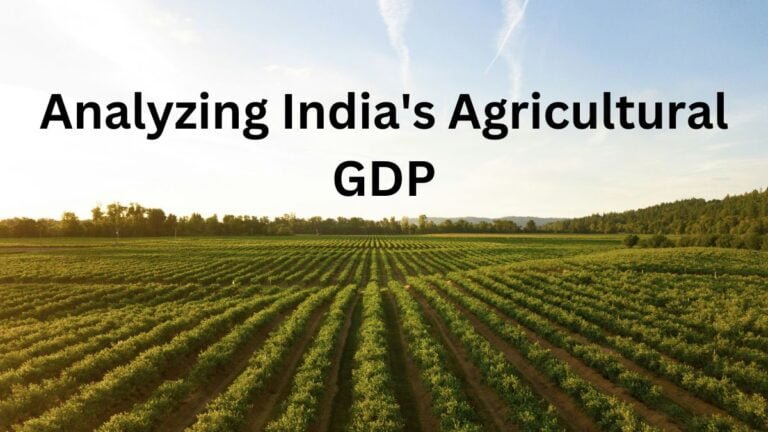India’s agricultural sector has long been a cornerstone of the country’s economy, contributing significantly to its Gross Domestic Product (GDP). This sector has employed a vast portion of the workforce and remains a critical driver of economic stability and growth.
According to the latest statistics, agriculture accounted for approximately 17-18% of India’s GDP in recent years, making it a vital area for both policymakers and economic analysts to monitor closely.
The agricultural landscape in India is diverse, encompassing a wide array of crops, from staple grains such as rice and wheat to various fruits, vegetables, and cash crops like cotton and sugarcane. This sector also extends to livestock and aquaculture, further diversifying its contribution to the overall economy.
Rural areas, where the majority of the population resides, are particularly reliant on agricultural activities, thus directly linking the sector’s performance to the socioeconomic well-being of millions.
Understanding the GDP from agriculture in India is crucial for several reasons.
- It offers insights into the health and productivity of the agricultural sector as a whole.
- By comparing agricultural GDP from 2023 to that of 2024, we can identify growth trends, measure the effectiveness of implemented policies, and assess the impact of external factors such as climate change, international trade, and technological advancements.
- Evaluating year-on-year changes helps in forming strategic plans that bolster resilience and sustainability within the sector.
This comparative analysis not only aids in crafting informed policies but also supports investment decisions, both public and private, aimed at fostering agricultural innovation and expansion.
Introduction to India’s Agricultural GDP
The performance of India’s agricultural GDP in 2023 was influenced by various factors, each playing a pivotal role in shaping the sector’s output and overall economic contribution. India’s agriculture remained a cornerstone of its economy, significantly impacting both rural livelihoods and national income.
Weather conditions were a notable influence on the agricultural GDP in 2023. The monsoon season, which is crucial for the majority of Indian crops, exhibited variability, impacting crop yields. Favorable precipitation in certain regions resulted in bumper harvests for staple grains such as rice and wheat. However, irregular rainfall patterns and instances of drought in other areas led to disparities in production, ultimately affecting the overall agricultural output.
Government policies also played a critical role in shaping the agricultural GDP. Initiatives such as subsidized inputs, minimum support prices, and credit schemes for farmers aimed at bolstering agricultural productivity and sustainability. Additionally, policy reforms introduced to streamline supply chains and reduce post-harvest losses showed promising results, contributing to the sector’s economic health.
Market trends during 2023 further influenced the agricultural GDP in India. The global demand for organic and sustainably sourced products saw an increase, leading to shifts in domestic farming practices. Farmers responding to these market signals diversified their productions to include higher-value crops, enhancing income stability and boosting the sector’s economic metrics.
Technological advancements in agriculture continued to drive efficiency and productivity. The adoption of precision farming techniques, improved irrigation methods, and the use of agricultural drones for monitoring crop health further optimized resource utilization. This technological integration supported higher yields and reduced input costs, benefiting the GDP from agriculture in 2023.
Collectively, these factors—enduring weather conditions, proactive policies, evolving market demands, and technological progress—shaped the agricultural GDP in 2023. Understanding these elements sets a foundational context for comparative analysis of the performance in 2024.
Factors Influencing Agricultural GDP in 2024
In 2024, several key factors are anticipated to affect the GDP from agriculture in India. These encompass a wide array of influences, such as governmental policy changes, technological advancements, climate variability, global market dynamics, and unforeseen disruptions like pandemics or political shifts.
Firstly, government policies play a pivotal role in shaping the agricultural sector. Adjustments in subsidies, tax incentives, and minimum support prices can significantly impact the economic viability of farming operations. Predictions indicate that enhancements in subsidy frameworks and investment in agriculture could stimulate growth. Furthermore, the promotion of sustainable agricultural practices through policy reforms is expected to drive positive trends in agricultural GDP.
Technological innovations are another crucial factor. The integration of advanced agritech, including precision farming, IoT (Internet of Things) devices, and AI-driven analytics, provides a promising outlook for improved productivity and efficiency. These technologies help in optimizing resource use, enhancing crop yields, and ensuring better management of agricultural practices, thereby potentially boosting the GDP from agriculture in India.
Climate patterns undeniably affect agricultural productivity. With climate change causing unpredictable weather changes, agricultural output could be significantly influenced. Notably, expert opinions suggest that initiatives aimed at improving irrigation infrastructure and promoting climate-resilient crops could mitigate adverse effects and support agricultural GDP.
Global market trends also have substantial implications. Fluctuations in international demand for Indian agricultural products, along with trade policies and tariffs, can alter export revenues. Additionally, global economic conditions and commodity prices will influence the earnings from agricultural exports.
Unforeseen disruptions such as pandemics or political instability can have profound impacts. The COVID-19 pandemic demonstrated vulnerabilities in supply chains and labor availability. Planning for such disruptions through resilient strategies is vital for stabilizing and potentially enhancing the agricultural GDP in the future.
Overall, while various factors could pose challenges, the collective influence of policy reforms, technological advancements, and strategic resilience measures holds promise for sustaining and possibly increasing the agricultural GDP in India for 2024.
Comparative Analysis: 2023 vs. 2024
In evaluating the GDP from agriculture in India for 2023 and 2024, several pertinent observations can be made. The agricultural GDP figures for both years show a nuanced landscape characterized by fluctuations in production volumes, crop yields, and economic contributions.
Examining crop yields reveals a mixed bag of results across different staple and cash crops. In 2023, the Indian agricultural sector experienced modest growth in rice and wheat yields, primarily due to favorable monsoon conditions. By contrast, 2024 saw a more pronounced increase in millet and pulse production, attributed to improved agricultural practices and the introduction of resilient crop varieties.
Economic contributions from the agricultural sector also paint an insightful picture. The total GDP share from agriculture in 2023 represented approximately 15.4% of India’s overall GDP, reflecting a consistent contribution to the national economy. However, 2024 witnessed a slight decrease, with agriculture accounting for about 14.8% of the total GDP. This minor decline can be partly attributed to rising urbanization and the growth of other economic sectors.
Analyzing production volumes underscores a critical observation: while 2023 saw steady production rates, 2024 marked a notable shift. There was a significant increase in horticultural output, particularly fruits and vegetables, bolstered by government incentives and technological advancements. Conversely, staple crop volumes such as rice and wheat observed stagnation, indicating the sector’s diversification trend.
Moreover, the numerical data reveal that government interventions and subsidies played pivotal roles in sustaining the agricultural GDP. Policies introduced in 2023 aimed at infrastructure improvement and financial support had a lingering impact, seen in the relatively stable agricultural performance in 2024. Challenges such as climatic variability and market access issues persisted but were somewhat mitigated by these strategic measures.
Overall, the comparative analysis of the Agricultural GDP Figures for 2023 and 2024 underscores a dynamic sector undergoing gradual transformation. Both years highlight distinct trends, with 2024 reflecting a sector that, while economically crucial, is increasingly influenced by broader economic shifts and technological advancements.
Government Policies and Their Impact
In recent years, the Indian government’s agricultural policies have been pivotal in shaping the sector’s economic performance. The 2023 and 2024 fiscal years witnessed a series of strategic interventions aimed at enhancing the GDP from agriculture in India. These interventions encompass subsidies, support programs, infrastructure development initiatives, and market regulations that collectively influence agricultural productivity and profitability.
In 2023, the government introduced substantial subsidies targeting essential inputs such as fertilizers, seeds, and irrigation. These subsidies were designed to reduce the financial burden on farmers, enabling them to invest in quality inputs and adopt advanced farming practices. Consequently, the increased productivity led to a noticeable rise in agricultural outputs, positively impacting the GDP from agriculture.
The government also implemented various support programs like the Pradhan Mantri Fasal Bima Yojana (PMFBY), which provides crop insurance to mitigate losses arising from natural calamities. Such programs ensured a safety net for the farmers, fostering stability and encouraging continuous investment in the agricultural sector. Moreover, the Kisan Credit Card (KCC) scheme facilitated accessible credit, reducing farmers’ dependence on informal lending sources, thereby further promoting agricultural growth.
Infrastructure development has been another critical area of focus. Significant investments were made in rural infrastructure, including better transportation networks, storage facilities, and market access points. As a result, farmers could efficiently transport their produce to broader markets, reducing post-harvest losses and increasing their income. Enhanced logistical frameworks directly contributed to the higher agricultural GDP by optimizing the supply chain and reducing wastage.
Market regulations and reforms, introduced in 2023 and extended in 2024, aimed at deregulating agricultural markets, provided farmers with the freedom to sell their produce beyond the traditional mandis (markets) directly. This policy aimed to enhance the farmers’ bargaining power and income, thereby stimulating the sector’s overall growth. Despite initial resistance and adaptation challenges, these reforms showed promising signs of efficiency and competitiveness.
Analyzing the cumulative impact of these policies reveals a correlation between proactive governmental measures and the improved GDP from agriculture in India. While the true extent of these policies’ effectiveness will continue to unfold, the preliminary outcomes indicate a positive trajectory in India’s agricultural GDP, reflecting the government’s strategic focus on this vital sector.
Technological Advancements Influencing Agricultural GDP
Over the past year, significant technological advancements have reshaped India’s agricultural landscape, with profound effects on agricultural GDP. The integration of cutting-edge farming equipment has allowed Indian farmers to cultivate land more efficiently and increase yield. Advanced machinery, such as automated tractors and precision sowing devices, has minimized manual labor, resulting in reduced time and effort for crop production. These technological innovations facilitate more consistent and accurate farming operations, which significantly elevates the overall agricultural output.
Moreover, breakthroughs in irrigation techniques have played a pivotal role. The introduction of smart irrigation systems that employ sensors and real-time data analytics has revolutionized water management in farming. These systems ensure optimal water usage by detecting soil moisture levels and adjusting irrigation patterns accordingly. By preventing both under-watering and over-watering, farmers achieve healthier crops and higher yields, contributing positively to the GDP from agriculture in India.
Advancements in crop management systems have greatly influenced productivity. Modern crop management software provides farmers with valuable insights regarding pest control, fertilizer application, and harvest timings. Through the analysis of vast datasets, these systems offer tailored recommendations, enabling farmers to make informed decisions that boost crop health and productivity. Leveraging such technology, Indian agriculture has seen a remarkable increase in efficiency and output.
Data analytics has emerged as a cornerstone of modern agriculture. By harnessing big data and machine learning algorithms, farmers can predict weather patterns, manage supply chains more effectively, and reduce post-harvest losses. This data-centric approach not only optimizes the farming process but also helps in strategizing for future crop cycles, ensuring sustained agricultural growth.
Overall, these technological advancements have collectively enhanced the productivity and efficiency of the agricultural sector, driving the upward trend in agricultural GDP. Through the adoption of innovative equipment, smart irrigation, crop management systems, and data analytics, India’s agriculture is witnessing a transformative phase, positioning it for continued growth and development.
The agricultural sector in India has faced numerous challenges in 2023 and 2024, significantly impacting the GDP from agriculture in the country. One of the foremost issues confronting this sector has been climate change, marked by erratic weather patterns, unseasonal rainfall, and prolonged droughts. These anomalies have led to fluctuating crop yields, making it difficult for farmers to sustain consistent agricultural output. Furthermore, pest infestations have exacerbated these issues, with significant crop losses due to invasive species that were resistant to conventional control methods.
Water scarcity has also emerged as a critical problem. With depleting groundwater levels and insufficient irrigation infrastructure, many regions have struggled to maintain adequate water supply for crops. This has particularly affected water-intensive crops like rice and sugarcane, thereby decreasing their overall contribution to India’s agricultural GDP. Additionally, land degradation, due to over-farming and the use of chemical fertilizers, has further diminished soil fertility, affecting crop productivity and, consequently, the economic output from agriculture.
Another pressing challenge is the shortage of labor. Migrant labor, an essential workforce for agricultural operations, has been unstable, exacerbated by the socio-economic disruptions caused by the pandemic. Labor shortages have led to delays in sowing and harvesting cycles, directly impacting agricultural efficiency and productivity. This shortage has pushed many farmers to adopt mechanized solutions, but the high cost of machinery is a barrier for small and marginal farmers.
To mitigate these issues, the Indian government and various stakeholders have implemented several measures. Investment in advanced irrigation techniques, adoption of climate-resilient crop varieties, and promotion of sustainable farming practices have been some key initiatives.
Incentivizing the use of organic fertilizers and providing training and support for mechanization aim to bolster productivity and reduce the adverse impacts on GDP from agriculture. Despite these efforts, the sector continues to grapple with these persistent challenges, necessitating continuous adaptation and policy support.
Future Outlook for Agricultural GDP in India
The future of agricultural GDP in India looks promising, with various trends and innovations expected to play a critical role. The government’s commitment to doubling farmers’ income by 2024 continues to drive significant policy changes, geared towards sustainable agricultural practices, increased investment in technology, and better access to markets.
One anticipated trend is the increased adoption of precision farming. Leveraging data analytics, IoT devices, and satellite imagery, precision farming can enhance crop yields and optimize resource use. This movement towards technology-driven agriculture could significantly boost the agricultural GDP from India by fostering more efficient practices and reducing wastage.
Another key factor is the advancement in biotechnology. Innovations in genetically modified crops can potentially improve resistance to pests and diseases, leading to higher productivity. Combined with sustainable practices, such as organic farming, these innovations are expected to strengthen the overall agricultural output, thus positively influencing the agricultural GDP in India.
Policy reforms also form an essential part of this outlook. The implementation of the Pradhan Mantri Fasal Bima Yojana (PMFBY) aims to reduce the financial risks associated with farming by providing crop insurance to farmers. Similarly, the e-NAM (National Agriculture Market) platform is set to transform the traditional agricultural market system, ensuring better price discovery and greater transparency. These policy initiatives will likely contribute to a more robust and resilient agricultural sector.
Expert predictions suggest a steady growth trajectory for India’s agricultural GDP, contingent upon continuous investment in research and development and the scaling up of sustainable practices. To sustain growth and address potential challenges, strategies such as enhancing irrigation infrastructure, promoting agroforestry, and investing in rural education are recommended.
Reflecting on the importance of continuous monitoring and support, it is clear that the agricultural sector remains a cornerstone of India’s economy. Therefore, ensuring its growth and stability through innovative strategies and supportive policies will be vital in navigating the dynamic landscape of global agriculture.


